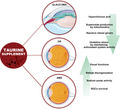- Record: found
- Abstract: found
- Article: found
Taurine and oxidative stress in retinal health and disease

Read this article at
Abstract
Retinal disorders are leading causes of blindness and are due to an imbalance between reactive oxygen species and antioxidant scavenger (in favor of pro‐oxidant species) or a disruption of redox signaling and control. Indeed, it is well known that oxidative stress is one of the leading causes of retinal degenerative diseases. Different approaches using nutraceuticals resulted in protective effects in these disorders. This review will discuss the impact of oxidative stress in retinal neurodegenerative diseases and the potential strategies for avoiding or counteracting oxidative damage in retinal tissues, with a specific focus on taurine. Increasing data indicate that taurine may be effective in slowing down the progression of degenerative retinal diseases, thus suggesting that taurine can be a promising candidate for the prevention or as adjuvant treatment of these diseases. The mechanism by which taurine supplementation acts is mainly related to the reduction of oxidative stress. In particular, it has been demonstrated to improve retinal reduced glutathione, malondialdehyde, superoxide dismutase, and catalase activities. Antiapoptotic effects are also involved; however, the protective mechanisms exerted by taurine against retinal damage remain to be further investigated.
Abstract
Increasing data indicate that taurine supplement may be effective in slowing down the progression of retinal diseases (including glaucoma, AMD, and DR), thus suggesting that taurine can be a promising candidate for the prevention or as adjuvant treatment of these diseases. The mechanism by which taurine supplementation acts is mainly related to the reduction of oxidative stress. Antiapoptotic effects are also involved; however, the protective mechanisms exerted by taurine against retinal damage remain to be further investigated.
Related collections
Most cited references121
- Record: found
- Abstract: found
- Article: not found
The pathophysiology and treatment of glaucoma: a review.
- Record: found
- Abstract: found
- Article: not found
